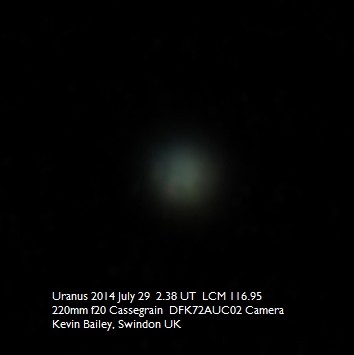Uranus comes to opposition on 7 October, and will be well placed for observing for much of the winter. If you have been struggling to find, or see much of, Neptune over the past month, then Uranus will be a welcome change, as it is about 6 times brighter (Magnitude 5.9), at 3.6″ almost twice the apparent diameter, 15 degrees higher in the sky, and in an easier part of the sky for finding things through through star hopping. The map below should help:
The Square of Pegasus should be easy enough to find looking south at around 11pm – the map shows the bottom 2 stars; directly below it the Circlet in Pisces is very distinctive, and from that you can follow a line of 4th magnitude stars East . The second and third of them are delta and epsilon, and Uranus is about 3 degrees south of them. Uranus is in theory just about visible with the naked eye (I have never managed it), but is certainly easy in binoculars, and these will enable you to identify the planet in relation to the other nearby stars of comparable brightness. Don’t expect to see any colour in binoculars, but through a reasonable sized telescope you should see both its distinctive blue -ish tinge, and a definite disc.
How much you see beyond that depends on the size and type of your telescope, the quality of the seeing, and your experience and patience as an observer. I have written elsewhere about the Uranus observing project. Now the planet is at opposition let’s hope it can get into full stride!
Imagers might want to have a go as well. Here is one from Kevin Bailey, which he made back in July.


